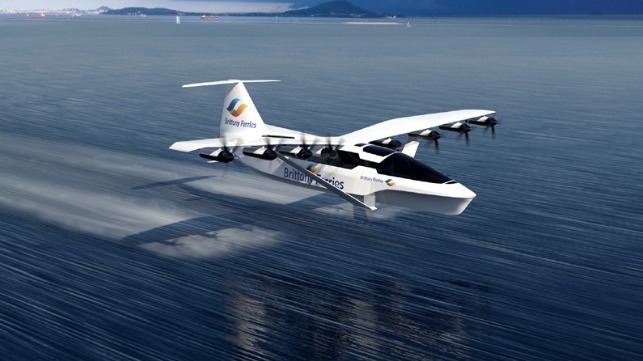Video: Brittany Ferries Explores Zero-Emission, Sea-Skimming Ferries

Brittany Ferries, which operates passenger ferries between England, Ireland, France, and Spain, is exploring the potential for a new high-speed, sustainable, and more efficient form of ferry travel called a seaglider. According to the company, the concept which is a combination of a hydrofoil and flies like a plane, yet classed as a vessel, could provide the comfort and convenience of a ferry at greatly increased speeds.
Drawing on the concepts for wing-in-ground effect vehicle (WIG) advanced by Soviet and German engineers in the 1960s, a Boston-based start-up REGENT (Regional Electric Ground Effect Nautical Transport) is developed a modern, all-electric, WIG that could become zero-emission flying ferries according to Brittany Ferries. REGENT expects the first commercial passengers to travel on smaller electric craft by 2025.
Brittany Ferries has signed a letter of intent with REGENT, which could produce seagliders with a 50-150 passenger capacity that could be sailing between the UK and France by 2028. The company said that the Seagliders would combine the convenience of passenger ferries with the comfort of hydrofoils, the aerodynamic efficiency of hovercraft, and the speed of aircraft. With the potential to connect existing ferry ports, the craft is expected to fly at speeds of up to 180 mph – six times faster than conventional ferries – with a battery-powered range of 180 miles. The voyage from Portsmouth to Cherbourg could be covered in as little as 40 minutes.
The design works by harnessing a concept well-known to pilots – ground effect. This is the cushion created by high-pressure air trapped between wings and the ground or water while flying at low altitude. Seagliders are therefore akin to a hovercraft with wings, rather than a skirt. Brittany said that it believes it’s a highly efficient mode of transport, capable of moving significant loads over long distances at high speed. Power will come from batteries rather than fossil fuels. Flight safety comes from redundant propulsion and flight control systems, with next-generation sensors detecting and automatically avoiding traffic at sea.

“Seaglider is an attractive and exciting concept, and we look forward to working with REGENT in the months and years to come,” said Frédéric Pouget, ports and operations director for Brittany Ferries. “We are particularly pleased to contribute now because it means we can bring real-world challenges and potential applications into the company’s thinking at an early stage. We hope this may help bring commercial success in the years that follow. Who knows; this could be the birth of ferries that fly across the Channel.”
REGENT reports that it is working on different sizes of passenger-carrying seagliders, all of which operate on the same principle. Following departure from port, the craft rises on foils, insulating passengers from wave discomfort. In open waters, it takes off, riding the air cushion to its destination. Wing-mounted propellers provide the thrust to take to the air at low speeds, while electric motors regulate air flow over wings while riding the air cushion.
Both Brittany Ferries and REGENT noted that many technological, practical, and regulatory milestones will have to be addressed to make this concept a reality. However, both companies say that caution should not stand as an impediment to the development of a promising concept that already has a history in military applications and smaller leisure craft operating around the world.

